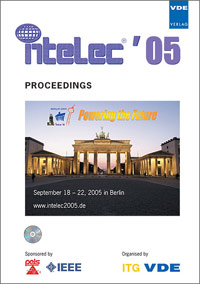Grounding, Equipotential Bonding - Lightning Protection Equipotenial Bonding based on the Example of a Transmission Network Station
Conference: Intelec '05 - Telecommunications Conference - 27th International Telecommunication Energy Conference
09/18/2005 - 09/22/2005 at Berlin, Germany
Proceedings: Intelec '05 - Telecommunications Conference
Pages: 8Language: englishTyp: PDF
Personal VDE Members are entitled to a 10% discount on this title
Authors:
Heimbürger, Thomas (Siemens AG, Munich, Germany)
Abstract:
Data transmission networks are the backbone of modern telecommunications networks. They handle the transport of the constantly increasing volume of data between the various network elements of the fixed network and form the link between fixed network and mobile networks. The two technologies listed below are used: a) cable-based transmission (these days mostly involving optical fiber cables); b) point-to-point radio system. The second technique is mostly used in inaccessible regions that lack the infrastructure to bridge long distances (30 - 120km). The target system availability of 100% can only be achieved using a secure power supply that also guarantees maximum supply stability under the least favorable boundary conditions. Anomalies in the AC network, such as transient overvoltage, temporary overvoltage or natural phenomena such as lightning discharges mainly endanger the components of the AC/DC power supply. The latter phenomenon has a particularly strong impact on point-to-point radio stations, which are often exposed and which have high towers. Lightning discharges represent an extremely high potential risk in many parts of Africa since the average value of lightning ground flash density per year far exceeds European values. Based on a risk analysis in line with DIN V VDE V 0185-2 (draft IEC 62305-2) and IEC 61663-1, the following paper explains the earthing, bonding and lightning protection measures on a transmission network station in Africa, in which point-to-point radio transmission is implemented as data transmission using optical fiber cables.


